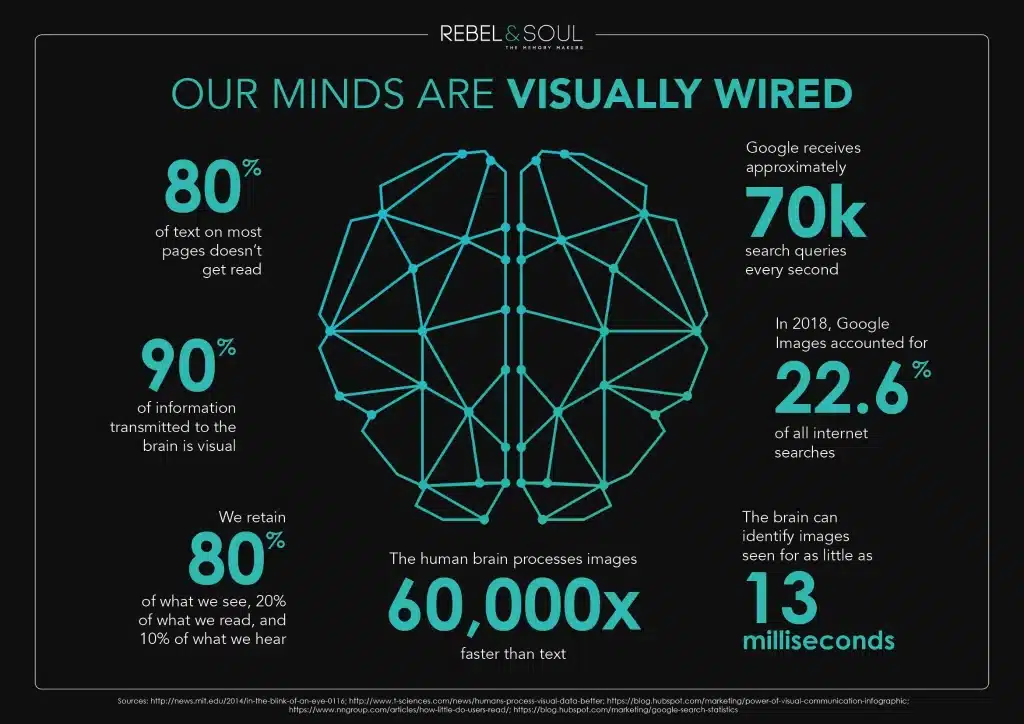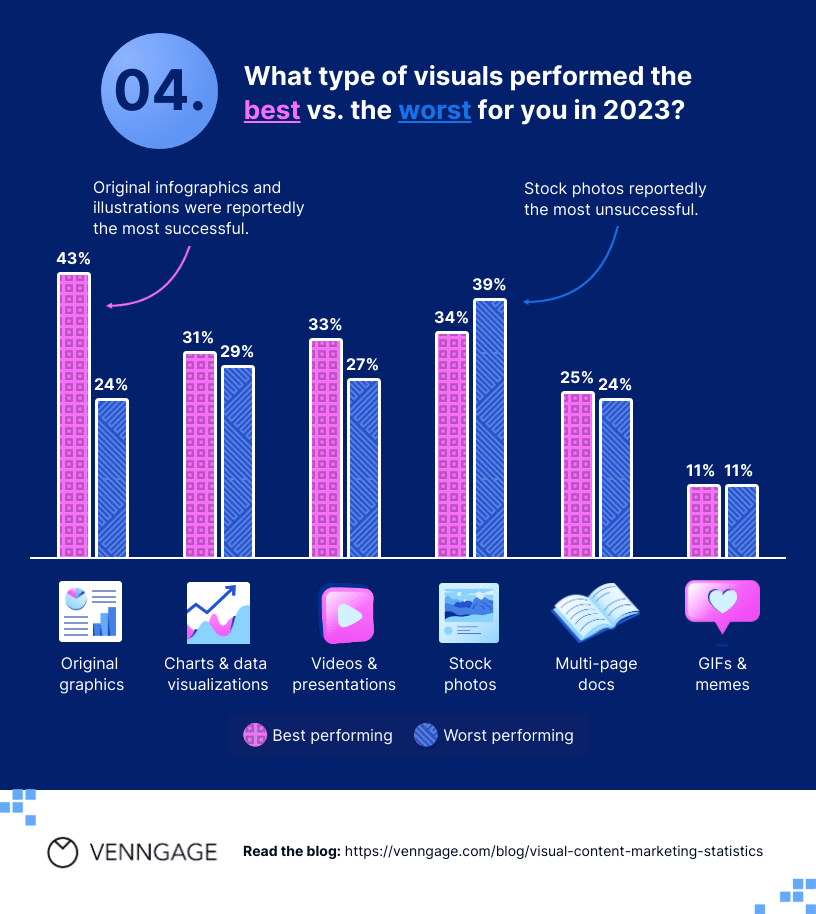
A picture might be worth 1000 words, but you might as well be speaking gibberish if your images aren’t engaging and relevant.
Images highlighting and accentuating the writing should accompany your content, keeping the reader on track and providing additional value. When it comes to content marketing, selecting the right pictures or graphics is a vital part of the process because it makes it more likely the reader will retain the information you present.
There’s research to back this idea up, as the average reader will only recall about 10% of written content three days after reading it. However, that individual will remember 65% of the information you present visually and verbally.
The images you choose are part of the puzzle, so you’ll want to put some effort into selecting the right ones. This guide will explain the importance of choosing the optimal images for content marketing and offer information on how to find them.
Quick Takeaways
- Engaging and relevant images are crucial in content marketing.
- These visuals enhance content comprehension by making it easier to grasp complex ideas.
- Factors like size, emotional impact, consistency with your brand, and relatability matter when selecting images.
- Understanding how to source images is vital to stay legal and ensure they align with your brand.
The Power of Image Relevance
In content marketing, selecting engaging images is like choosing the right spices for a recipe – they can make all the difference. Here’s why image relevance matters:
Capturing Attention
There’s so much content out there that standing out from the crowd is next to impossible. However, when an image aligns with your content’s theme or message, it creates an instant connection, enticing viewers to stop scrolling and dig deeper into what you have to say.
Enhancing Understanding
Relevant images provide visual cues that complement your written content, making it easier for your audience to grasp complex ideas or emotions. They guide the reader, helping them understand content that could otherwise be challenging.
Improving Recall
Our brains are wired to remember visuals better than text. By incorporating relevant images, you’re giving your audience memory boosters. When they reflect on your content, those images serve as mental bookmarks, helping them recall your message with clarity and ease. Since 85% of buying decisions are made on an unconscious level, it makes sense to access that part of the brain.
Increasing Engagement
Relevant images can evoke emotions and spark conversations. They add flavor to your content, making it more engaging and encouraging interaction. The result is a deeper connection with your audience.

Selecting relevant images for your content isn’t just about aesthetics; it’s about strategically enhancing every aspect of the reader’s journey. It grabs their attention and leaves a lasting impression, so you’re on their minds well after they leave your website.
Tips for Selecting (Seemingly) Original Photos
A lot of marketers struggle when sourcing images. While we’d all love exclusive access to an arsenal of custom photos, videos, and infographics, most marketers lack those resources.
The search for unique images is challenging, and today’s media-savvy audiences add to the problem. Legal repercussions are possible when using images illegally, too, which is a path we don’t want to go down.
If you rely on stock photos, there are some steps you can take to get the most from those pictures. Here are some tips on selecting images that resonate with your audience while staying on brand:
- Consider the Size – Ensuring your images are the right size for your website is critical. If an image is pixelated or poorly produced, it will hurt your brand. Selecting high-definition images in the appropriate sizes is a great place to start.
- Elicit An Emotion – Finding images that evoke emotion can help with brand recognition. Your readers are unlikely to remember your specific content for long, but the feeling you give them will last well into the future.
- Be Consistent – From the tone you use in your writing to the images you select, you want everything you produce to fall within your brand’s scope. For example, if you run a healthcare client’s website, the tone should be more clinical than conversational. The same goes for the images on the website. Consistency also applies to the cropping and filters you apply to your image. If all your images are black and white, you do not want to put a vibrantly colored photo in one blog post.
- Stay Relatable – If you use images of people in your content marketing campaigns, ensure they reflect your target audience. For example, if your customer base is primarily young professionals, using an image of a mid-50s C-Suite executive will not work.
Original infographics are the best-performing visuals, but stock photos aren’t that bad and compare favorably to video presentations and charts. It all depends on how you use them.

Your images might not be original, but your customers are less likely to notice if the pictures fit the rest of the brand’s profile. Selecting the right photos lets you speak directly to customers, helping generate the desired response.
Sourcing Your Visual Content
While using your own images is ultimately best when developing your content marketing strategy and keeping your legal team out of your day-to-day activities, various resources are available to those who need them. Here’s a quick overview of some terms you’ll see and what they mean.
- Stock Photos – These typically high-quality images allow you to filter through topics to find something relevant to your content. Stock photos is a blanket term that applies to various image types.
- Creative Commons – You can use these images for free, although attribution is recommended and sometimes required.
- Editorial Use – You can’t use these images for commercial reasons, only editorial content.
- Rights-Managed – These stock photos have a one-time use limitation per purchase. You’ll have to buy the rights a second time to re-use the image.
- Public Domain – You can use these images as much as you want for any purpose without attribution.
- Royalty-Free Images – These high-quality photos are usually less expensive than stock photos, and you can use them multiple times without paying extra. However, you can’t edit or resell the image.
Sourcing images through these channels will make your life easier as a marketer because of the sheer volume available. However, there are multiple sites you’ll want to look at to ensure you end up with the best possible images to suit your brand.
Best Places to Find Images For Content Marketing
Where do you find stock images? There are plenty of spots to look, and there’s something for every campaign and budget.
For all images, please check the copyright status and attribution requirements. This step will prevent many future headaches.
Some of the best places to find stock images include the following:
This list isn’t exhaustive, and you’ll undoubtedly find alternatives as you search. Just remember to use all images legally and ensure they match your brand for the best results.
The Visual Side of Content Marketing
Using images as part of your content marketing strategy is about more than aesthetic appeal. There are scientific reasons these visuals work and can drive traffic for your brand moving forward.
If the mere thought of sourcing and attributing images sends a chill down your spine, we’ve got you covered with our Content Builder Service. Reach out to learn more, or book your free consultation today.


0 Commentaires